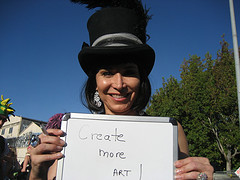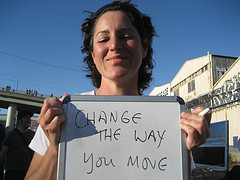“We want help solving our problems, both significant and commonplace. We want help improving our lives. We want help making sense out of world fraught with uncertainty.” — Jay Bear, Convince and Convert
It’s a day for thinking about the planet, and how to repair our world. There are many different ways. Sometimes it’s just hard to get started. The problems seem so insurmountable… it’s hard to envision making a difference.
Your job, as a nonprofit fundraiser and marketer, is to help folks see how they can influence the outcome. Then, you must help them to do it. Guide them towards being the change they want to see in the world. Persuade them that your cause is a fantastic way to achieve this change. Your cause may be one cause among many picked by your constituents; that’s fine. Your task is simply to (1) engage them to act, and (2) entice them to choose your organization to facilitate that action.
How do you turn thoughts into action that improves lives?
You begin by doing everything in your power to understand what your constituents are thinking and feeling. No guessing. No wishing. No assuming. Find out.
Once you understand what drives your folks, then you can persuade. Persuade, not convince. Persuasion gets people to think and do. Convincing gets people only to think. You must guide folks down the path towards action. We are persuaded by appeals made to the will, moral sense or emotions. We are convinced by evidence or arguments made to the intellect. But no ranting, bombasting, pontificating or arm twisting. Persuasion is a gentle art.
Persuade folks to overcome their inertia. Anne Frank famously wrote: “How wonderful it is that nobody need wait a single moment before starting to improve the world.” The problem is that sometimes it’s a lot easier to wait. Inertia – the tendency to do nothing – is powerful. Your job is to help folks overcome their inertia. Here are some ways to make this happen:
Towards Understanding — Actionable Tips:
1. Listen. Here’s the deal about listening: You can’t do it if you don’t encourage conversation. Whether you’re talking with someone face-to-face or online, you’ve got to get them to open up and offer information about themselves. Ask open-ended questions (e.g., “How did you… What would you… Why should we… Who would be best to…). Notice things about them (e.g., photos on the wall, books on their shelves, or the fact that they just returned from vacation) and ask about them. When thanking them for their gift, go one step further and ask what inspired them. Then acknowledge what you’ve heard (and don’t forget to record it in your database so you don’t forget). Ever hear someone say “I hear what you’re saying?” It’s a trigger that lets you know you’ve been heard and understood.
2. Ask. This may seem readily apparent and common sense, but we often ignore the obvious. If you want to know something, ask. In person. On the phone. Online. On a remit piece. Or do a simple survey using Survey Monkey (there’s a free version) or Google Docs (also free, and their You Tube video walks you through the process). Asking has the added bonus of delighting folks that you care about their advice and/or opinion.
3. Research. This is basically plan-ahead listening. And it’s essential to your ability to show folks you know who they are and what they care about. Incorporate research into your work plan and enlist the support of your colleagues and boss to make this an organization-wide commitment. Some ideas:
- Ask front-line staff (e.g., receptionist, office or program manager, database manager who handles donor inquiries or complaints, ) to make notes of frequently asked questions. . Research shows that those with the most power/status are usually those who are furthest away from being perceptive about your constituents’ needs and wants.
- Take note of what questions people are asking via email or social media.
- See where conversations are happening on the social web relevant to the type of work you do.
- Google FAQs for your industry, or see what questions are being asked on forums like Quora or Yahoo Answers.
- Go to Amazon and find a book that’s about something in your industry (e.g. health care; education; arts; environment). ! Go to Click on the turned-down page and enter into the Table of Contents. You’ll find plenty of information that points to customer problems and unanswered questions.
Towards Persuading – Actionable Tips:
4. Offer relevant, reader-centric content. Stuff that solves people’s personal problems. Stuff that shows folks how to help solve the community or societal problems that bother them. Commit to helping, not selling. Social media and content strategist Jay Baer calls this “Youtility.” Get it? Your messaging should be all about the folks you hope to persuade. Them, not you. So stop writing e-newsletters and blog posts about the awards you’re winning, the programs you’re running and the board members you’re recruiting. Write about people being helped, educated, inspired, healed… all the positive outcomes that move your supporters to pay attention. Lay out the tools and techniques that you use, so they can use them too. Perhaps a tip sheet on how to talk to children about violence… how to make a home safe for seniors or children…. how to care for a rescued pet… how to find the top books and movies around your area of engagement?
5. Tell stories. This is absolutely the best way to tell folks stuff in a manner that engages. We’re wired to listen to information through stories. People remember stories. Tell your story with purpose, passion and a plan. And don’t forget – board members like stories too. Don’t just stuff your board meetings with dry facts and figures and policy discussions. Tell a few stories about what you’re doing in the field that’s changing lives. That’s what they’ll remember. That’s what they’ll share with friends and family.
6. Show pictures. It’s often been said that seeing is believing; the research bears this out. A new guide to visual storytelling practices reveals that when information is presented orally only, people who are tested 72 hours later remember only about 10% of what they heard. That jumps to 65% when pictures are added!
7. Personalize. Find ways to really show folks you’ve listened to them in the past, and that you remember who they are [See Philanthropy, Not Fundraising: How to Win Over Donors in One Word for specific personalization suggestions].
Tap into what’s important in peoples’ lives. Then you don’t have to sell. You don’t have to “fund raise.” You can just make a match between their values and yours. You can create a relationship where money is not the central thing you’re talking about. Money is just a symbol of what it can accomplish. It’s only money.
You’ve got what people want; you just have to show them. Social change today is valued; sell your impact.
People have to care before they’ll commit to act. To get them to care about you, you’ve got to care about them. It’s a shift in mindset. It’s how you tinker with your internal thought processing to move from fundraising to philanthropy facilitating. Have you made the shift?
Think about one thing you can do this week to make the shift towards Youtility. If you’re willing, please share your ideas below in comments. Thanks, and HAPPY EARTH DAY!











